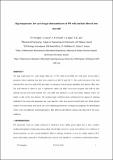High temperature, low cycle fatigue characterisation of P91 weld and heat affected zone material
Date
2014-01-08Author
Farragher, Tadhg P.
Leen, Sean B.
Metadata
Show full item recordUsage
This item's downloads: 856 (view details)
Cited 19 times in Scopus (view citations)
Recommended Citation
T.P. Farragher, S. Scully, N.P. O'Dowd, C.J. Hyde, S.B. Leen (2014) 'High temperature, low cycle fatigue characterisation of P91 weld and heat affected zone material'. Journal Of Pressure Vessel Technology, 136 (021403).
Published Version
Abstract
The high temperature low cycle fatigue behavior of P91 weld metal (WM) and weld joints (cross-weld) is presented. Strain-controlled tests have been carried out at 400 °C and 500 °C. The cyclic behavior of the weld material (WM) and cross-weld (CW) specimens are compared with previously published base material (BM) tests. The weld material is shown to give a significantly harder and stiffer stress–strain response than both the base material and the cross-weld material. The cross-weld tests exhibited a cyclic stress–strain response, which was similar to that of the base material. All specimen types exhibited cyclic softening but the degree of softening exhibited by the cross-weld specimens was lower than that of the base material and all-weld tests. Finite element models of the base metal, weld metal and cross-weld test specimens are developed and employed for identification of the cyclic viscoplasticity material parameters. Heat affected zone (HAZ) cracking was observed for the cross-weld tests.
Description
Journal article


